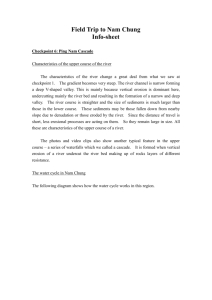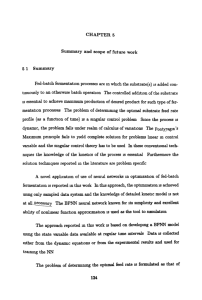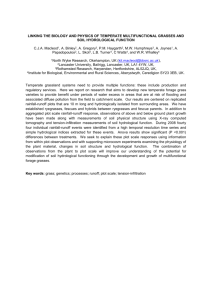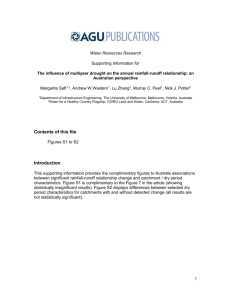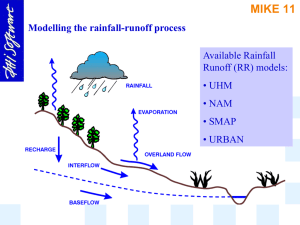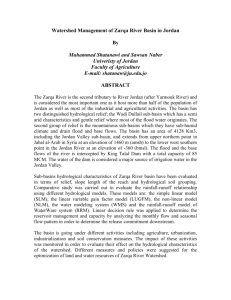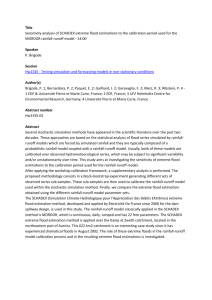Performance comparison of a conceptual hydrological model and a
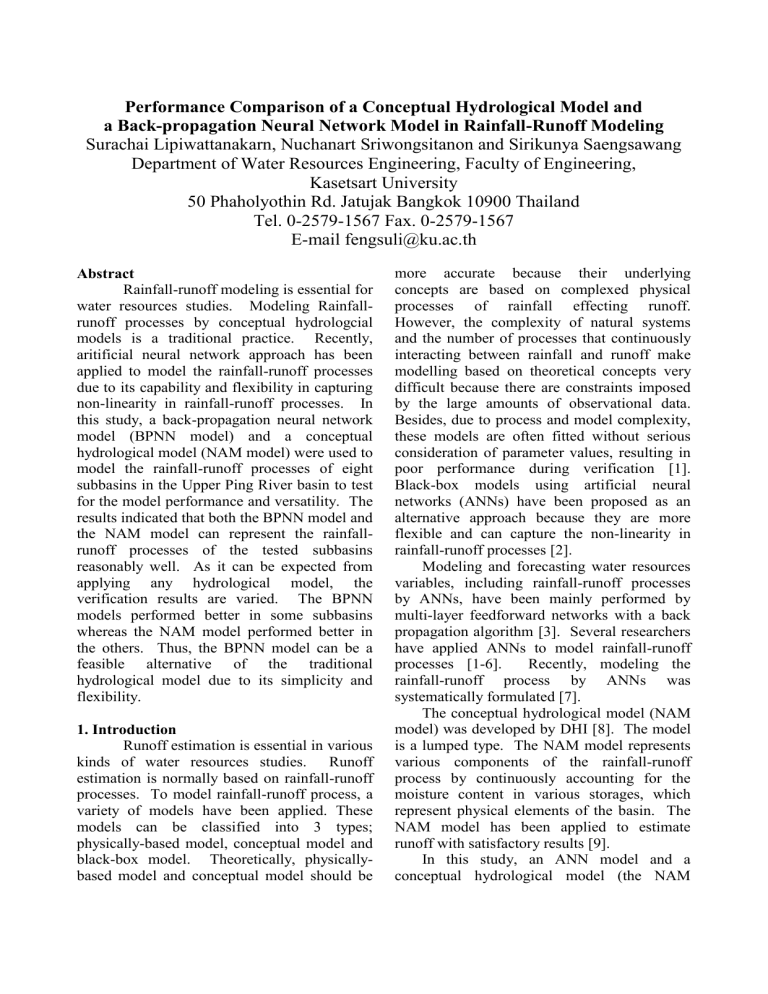
Performance Comparison of a Conceptual Hydrological Model and a Back-propagation Neural Network Model in Rainfall-Runoff Modeling
Surachai Lipiwattanakarn, Nuchanart Sriwongsitanon and Sirikunya Saengsawang
Department of Water Resources Engineering, Faculty of Engineering,
Kasetsart University
50 Phaholyothin Rd. Jatujak Bangkok 10900 Thailand
Tel. 0-2579-1567 Fax. 0-2579-1567
E-mail fengsuli@ku.ac.th
Abstract
Rainfall-runoff modeling is essential for water resources studies. Modeling Rainfallrunoff processes by conceptual hydrologcial models is a traditional practice. Recently, aritificial neural network approach has been applied to model the rainfall-runoff processes due to its capability and flexibility in capturing non-linearity in rainfall-runoff processes. In this study, a back-propagation neural network model (BPNN model) and a conceptual hydrological model (NAM model) were used to model the rainfall-runoff processes of eight subbasins in the Upper Ping River basin to test for the model performance and versatility. The results indicated that both the BPNN model and the NAM model can represent the rainfallrunoff processes of the tested subbasins reasonably well. As it can be expected from applying any hydrological model, the verification results are varied. The BPNN models performed better in some subbasins whereas the NAM model performed better in the others. Thus, the BPNN model can be a feasible alternative of the traditional hydrological model due to its simplicity and flexibility.
1. Introduction
Runoff estimation is essential in various kinds of water resources studies. Runoff estimation is normally based on rainfall-runoff processes. To model rainfall-runoff process, a variety of models have been applied. These models can be classified into 3 types; physically-based model, conceptual model and black-box model. Theoretically, physicallybased model and conceptual model should be more accurate because their underlying concepts are based on complexed physical processes of rainfall effecting runoff.
However, the complexity of natural systems and the number of processes that continuously interacting between rainfall and runoff make modelling based on theoretical concepts very difficult because there are constraints imposed by the large amounts of observational data.
Besides, due to process and model complexity, these models are often fitted without serious consideration of parameter values, resulting in poor performance during verification [1].
Black-box models using artificial neural networks (ANNs) have been proposed as an alternative approach because they are more flexible and can capture the non-linearity in rainfall-runoff processes [2].
Modeling and forecasting water resources variables, including rainfall-runoff processes by ANNs, have been mainly performed by multi-layer feedforward networks with a back propagation algorithm [3]. Several researchers have applied ANNs to model rainfall-runoff processes [1-6]. Recently, modeling the rainfall-runoff process by ANNs was systematically formulated [7].
The conceptual hydrological model (NAM model) was developed by DHI [8]. The model is a lumped type. The NAM model represents various components of the rainfall-runoff process by continuously accounting for the moisture content in various storages, which represent physical elements of the basin. The
NAM model has been applied to estimate runoff with satisfactory results [9].
In this study, an ANN model and a conceptual hydrological model (the NAM
model) were used to model rainfall-runoff processes on a daily basis. The results from the two models were compared to assess their performances.
2. Study Area and Data Set
The study area is the Upper Ping River basin, located in northern Thailand as shown in
Figure 1. Eight subbasins of the Upper Ping
River basin were used in the study. The data used in this study were daily river discharge and daily rainfall data located in each subbasin and daily evaporation data from a meteorological station in Chieng Mai province.
Details of the subbasins are shown in Table 1.
The catchment areas of the subbasins range from 460-3,853 km 2 . Number of rainfall stations in each subbasin are small comparing to its basin size which might affect the performance of the models. The selected
Figure 1 Upper Ping River basin training (calibration) and testing (verification) periods are also identified in Table 1. The years are varied from basin to basin ranging from 1974 to 2000. This will be useful in evalutating the robustness and versatility of the models as representatives of the rainfall-runoff processes with various hydrological conditions.
However, due to limitations of available data, the period of data used in each training and testing periods are only between 2-4 years.
3. Methodology
3.1 Back Propagation Neural Networks
(BPNNs)
BPNNs are mathematical models with a highly connected structure inspired by the structure of the brain and nervous systems.
BPNN processes operate in parallel, which differentiates them from conventional computational methods. BPNNs consist of multiple layers - an input layer, an output layer and one or more hidden layers - as shown in
Figure 2.
Each layer consists of a number of nodes or neurons which are inter-connected by sets of correlation weights. The input nodes receive input information that is processed through a non-linear transfer function to produce outputs to nodes in the next layer.
These processes are carried out in a forward manner. The learning or training process uses a supervised learning algorithm that compares the model output to the target output and then adjusts the weight of the connections in a backward manner hence it is called a back propagation neural network model. The process can be summarized in mathematical form as follows.
From Figure 2, given a set of input nodes, X i
, the values are multiplied by their associated weights, W ji
. The summation of the products can be written as: net j
N
i
0
W X i
(1) where X o
and W jo
are the bias (X o
= 1) and its bias weight, respectively. N is the number of input nodes. Each hidden node input (net j
) is then transformed through the non-linear
Table 1 Subbasin characteristics
Number
1
6
7
8
2
3
4
5
Basin code
P24A
P21
P34
P28
P20
P71
P4A
P14
Basin name
Mae Klang
Mae Rim
Mae Kuang
Mae Ngat
Upper Ping Part 1
Mae Khan
Mae Taeng
Mae Chaem
X
0
W j0
X
1
W j1
X
2
W j2 net
1 net
2
W k1
W k2 Z k
X
3
W j3 net
3
W k3
Output
Layer
X
4
W j4
Hidden
Layer
Input
Layer
Figure 2 The structure of the BPNN transfer function to produce a hidden node output, Y j
. The most common form of the transfer function is a sigmoid function as given in Eq. (2)
Y j
f ( net j
)
1
1 e
net j
(2)
Similarly, the output values between the hidden layer and the output layer are defined by
M
j
0
W Y j
(3)
Z k
f ( net k
)
1
1 e
net k
(4) where M is the number of hidden nodes, W kj
is the connection weight from the j-th hidden
Catchment area
(km 2 )
460
515
565
1,261
1,355
1,771
1,902
3,853
No. of rainfall stations
1
2
2
2
2
2
2
3
Training duration
Testing duration
1992-1996 1997-1999
1985-1989 1982-1984
1976-1978 1979-1980
1974-1976 1977-1978
1997-1999 1991-1992
1999-2000 1996-1997
1992-1994 1995-1996
1989-1993 1986-1988 node to the k-th output node and Z k
is the value of the k-th output node.
3.2 BPNNs formulation
BPNN models were formulated by using a short period of historical rainfall data and antecendent precipitation index (API) as inputs and discharge as an output. The determination of appropriate lags for rainfall data can be performed by a prior knowledge of the rainfall-runoff process in conjunction with inspections of correlation plots between potential inputs and outputs [3], or a sensitivity analysis and a multivariate analysis [10].
However, in this study, the contribution of weights from potential inputs to an output of a
BPNN model without a hidden layer for each subbasin was used to determine the appropriate lags since the weights can be viewed as coefficients in a multiple linear regression analysis. The relation between weights and potential inputs was determined based on one year data.
The Stuttgart Neural Network
Simulator, SNNS [11], was selected to perform the BPNN simulations. Training was based on a back-propagation with momentum algorithm.
Networks with only three layers were selected for all models.
The BPNN model runs were performed using a split-sample technique. Accordingly, the data were split into 2 sets: a training set and a testing set. The training data set was used to train the model whereas the testing data set was used to verify the effectiveness of the trained model in non-trained events.
The antecedent precipitation index
(API) used in this study was defined by: [12]
API
( API
1
P t
t
) e
t
(5) where API t
is an antecedent precipitation index at time t, P t-1
is rainfall amount at time t-1,
t is a time step (daily basis) and
is a constant. In this study,
was taken as 0.01.
For BPNN simulations, all data were normalized in the range 0.05 and 0.95 to decrease the effect of the magnitude of the different variables and to enable the use of a sigmoid function as the transfer function.
3.3 A conceptual hydrological model (NAM
model)
The rainfall-runoff processes were calibrated and verified using the NAM model, which is a conceptual rainfall-runoff model.
The model is a lumped type, i.e. the basin is considered as a whole. The NAM model represents various components of the rainfallrunoff process by continuously accounting for the moisture content in four different but interrelated storages, which represent physical elements of the basin as shown in Figure 3.
These storages are snow storage (if any), surface storage, lower zone storage and groundwater storage. The meteorological input data are precipitation and evaporation and the result is catchment runoff. The resulting runoff is split conceptually into overland flow, interflow and baseflow components.
U max
L max
Precipitation
Surface Storage U
E p
Interflow
Overland flow
L
E a
Root Zone
Ground Water
Capilary flux
Baseflow
The principle of the NAM model is based on physical structures and equations used together with semi-empirical ones.
Precipitation is intercepted on the vegetation as well as trapped in depression on the surface storage. The amount of water in the surface storage is continuously evaporated and part of it becomes interflow. When the surface storage is filled, the excess water will enter the streams as overland flow, whereas the remainder is diverted as infiltration into the lower zone and groundwater storages.
The main parameters of the NAM model are U max
(maximum water content in the surface storage), L max
(maximum water content in the root zone storage), CQOF (overland flow runoff coefficient) CKIF (time constant for interflow), TOF (threshold value for overland flow), TIF (threshold value for interflow), TG
(threshold value for groundwater recharge),
CK
1
, CK
2
(time constant for routing interflow and overland flow—it is a normal practice to set CK
1
equal to CK
2
) and CKBF (time constant for routing baseflow). More details of the NAM model can be found in [8] and [13].
Nine parameters of the NAM model were calibrated and verified for eight subbasins using the same data sets as for the BPNN model.
3.4 Evaluation measures for the model
performance
The results of the models applied in the study were evaluated for their performance by estimating the following standard global statistical measures.
1. Root mean square error (RMSE)
RMSE
N i
( Q obs , i
N
Q s im , i
)
2
1 / 2
(6)
Figure 3 The structure of NAM model
The root mean square error defined by
Eq. (6) measures the average error between the observed and the simulated discharges, where
Q obs
is the observed discharge, Q sim
is the
simulated discharge and N is the number of observations. The closer the RMSE value is to zero, the better the performance of the model.
The RMSE was used to measure the agreement between the observed and simulated water
For training or calibration period, the
BPNN model gave the better statistical measures in all the subbasins. Although the
NAM model gave worse results in the calibration period but the performance statistics balance.
2. Efficiency index (EI)
2
The zero value means the model performs equal to a naive prediction, that is, a prediction using an average observed value. The value less than zero means the model performs worse than the average observed value. A value between 0.6-0.8 is moderate to good. A value more than 0.8 is a good fit. A value of one is a perfect fit.
EI 1
i
N
1 i
N
1
Q obs , i
Q obs , i
Q s im , i
2
(7)
Q obs
The efficiency index or Nash-Sutcliffe criterion [14] as shown in Eq. (7) is often used to measure the performance of a hydrological model. The value is in the range of [-
, 1]. of the NAM model were not far from the
BPNN. The EI statistics of the BPNN model were ranging from 0.55 to 0.80 for training period whereas the EI statistics of the NAM model were ranging from 0.42 to 0.72. The
RMSE statistics of both models were close together. The training and calibration results indicated that in general both the BPNN and the NAM models can represent the nonlinear relationships between rainfall and runoff.
For testing or verification period, the
BPNN model gave the better results in five subbasins while the NAM model gave the better results in three subbasins. As it can be expected from applying any hydrological model, the verification results are normally varied from basin to basin and from model to model. However, the BPNN model and the
NAM model had low performance in some subbasins with low EI statistics. The lowest EI statistics for the BPNN and the NAM models
4. Results and Discussions
The results of the BPNN and NAM models applied to all eight subbains are given in Table 2. The better values are given in bold.
As expected, the root mean square error were 0.13 and 0.12, respectively. The ranges of the better EI statistics for the testing
(verification) period were between 0.46-0.67 for the BPNN models and 0.34-0.51 for the
NAM models. The RMSE statistics of both models for the verification period were also
(RMSE) statistics are directly related to the basin size whereas the efficiency index (EI) statistics are not. However, the results of both statistics agree with each other. close together. These results indicated that
BPNN model can be a feasible alternative of the traditional hydrological model due to its simplicity and flexibility.
Table 2 Results of the BPNN and NAM models performance
Basin name Catchment area Root mean square error (RMSE)
(km 2 ) BPNN model NAM model
Efficiency index (EI)
BPNN model NAM model
Trg. Test. Cal. Ver. Trg. Test. Cal. Ver.
Mae Klang
Mae Rim
Mae Kuang
Mae Ngat
Upper Ping Part 1
Mae Khan
Mae Taeng
Mae Chaem
460
515
565
1,261
1,355
1,771
1,902
3,853
5.47 2.72 5.61 2.36 0.55 0.13 0.53 0.34
3.15 3.98 3.47 3.83 0.70 0.47 0.63 0.51
4.57 3.37 7.50 3.66 0.80 0.52 0.45 0.43
10.87 11.67 12.82 12.59 0.80 0.55 0.72 0.48
5.90 6.75 6.80 8.62 0.72 0.46 0.63 0.12
9.40 7.90 14.25 8.25 0.75 0.67 0.42 0.64
11.13
18.34
14.56
24.43
12.85
20.93
Trg.- Training: Test.-Testing: Cal.-Calibration: Ver. Verification.
19.90
21.00
0.76
0.60
0.64
0.28
0.68
0.48
0.34
0.47
It is interesting to note that although the
RMSE and the EI statistics agree with each other, the magnitudes of them in evaluating the model performance can be different. For example, in Mae Klang basin, the RMSE statistics of the BPNN and the NAM model for verification period were 2.72 m 3 /s and 2.36 m
3
/s, respectively, while the EI statistics for the same period were 0.13 and 0.34, respectively.
The ratio of the RMSE statistics was only 1.15 times whereas the ratio of the EI statistics was
2.73 times. However, both statistical measures are based on the same basic statistics – mean square error (MSE) – and can be converted or recalculated to each other. Thus, when using only one criterion, special care should be taken in order not to misinterpret the statistics.
Therefore, to assess the model performance more precisely, more than one criterion should be used.
5. Conclusions
In this study, a conceptual hydrological model (NAM model) and a back-propagation neural network model (BPNN model) were used to simulate rainfall-runoff processes.
Eight subbasins of the Upper Ping River basin were selected with different calibration and verification periods to test for model versatility in modeling various hydrological conditions.
The periods of data used in the study were between 2-4 years. The results of both models were compared to assess their performance within limited data used. The results indicated that both the BPNN model and the NAM model can represent the rainfall-runoff processes of the tested subbasins reasonably well although without considering a seasonal effect. As it can be expected from applying any hydrological model, the verification results are varied. The BPNN models performed better in some subbasins whereas the NAM model performed better in the others. Thus, the
BPNN model can be a feasible alternative of the traditional hydrological model due to its simplicity and flexibility.
6. Acknowledgement
The work presented here has been supported by the Kasetsart University Research and Development Institute (KURDI) under the grant number 01009489. The authers wish to thank an anonymous reviewer for helpful suggestions which led to improvements in the manuscript.
References
[1] M.R. Gautam, K. Watanake, and H.
Saegusa, H., “Runoff analysis in humid forest catchment with artificial neural network”, J. Hydrol., Vol. 235, 2000, pp.117-136.
[2] K. Hsu, H.V. Gupta, H.V. and S.
Sorooshian, “Artificial neural network modeling of the rainfall-runoff process”,
Wat. Resour. Res., Vol. 31(10), 1995, pp.
2517-2530.
[3] H.R. Maier and G.C. Dandy, “Neural networks for prediction and forecasting of water resources variables : a review of modeling issues and applications”,
Environ. Modeling & Software, Vol. 15,
2000, pp. 101-124.
[4] A.W. Minns and J. Hall, “Artificial neural networks as rainfall-runoff models”,
Hydrol. Sci. J., Vol. 41(3), 1996, pp. 399-
417.
[5] A.Y. Shamseldin, “Application of a neural network technique to rainfall-runoff modeling”, J. Hydrol., Vol. 199, 1997, pp.
272-294.
[6] M.P. Rajurkar, U.C. Kothyari, and U.C.
Chaube, “Modeling of the daily rainfallrunoff relationship with artificial neural network”, J. Hydro., Vol. 285, 2004, pp.
96-113.
[7] C.W. Dawson and R.L Wilby,
“Hydrological modelling using artificial neural networks”, Progr. Phys. Geogr .
,
Vol. 25(1), 2001, pp. 80-108.
[8] Danish Hydraulic Institute (DHI), “NAM
Technical Reference and Model
Documentation”, 1999.
[9] K. Kooprasert and N. Sriwongsitanon,
“Study on NAM parameters for Nan river basin”, Proc. of 41 st
Kasetsart University
Annual Conf., 2003, pp.185-192. (in Thai)
[10] O.R. Dolling and E.A. Varas, “Artificial neural network for streamflow prediction”,
J. Hydraul. Res., Vol. 40(5), 2002, pp.
547-554.
[11]
A. Zell, et. al., “SNNS Stuttgart Neural
Network Simulator User Manual, Version
4.2”, University of Stuttgart and
University of Tubingen, 2000.
[12] L. Descroix, J.-F. Nouvelot and M.
Vauclin, “Evaluation of an antecedent precipitation index to model runoff yield in the western Sierra Madre (North-west
Mexico)”, J. Hydrol., Vol. 263, 2002, pp.
114-130.
[13] Madsen, H., 2000. “Automatic calibration of a conceptual rainfall-runoff model using multiple objectives”, J. Hydrol., Vol. 235,
276-288.
[14] J.E. Nash and J.V. Sutcliffe, “River flow forecasting through conceptual models, part 1 – A discussion of principles”, J.
Hydrol., Vol. 10, 1970, pp. 282-290.

